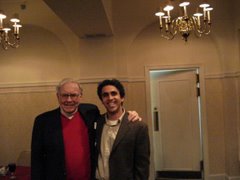Warren Buffett on June 25, 1999 (Business Week)
By now most of us our familiar with this statement from Warren Buffett or have heard something similar. Well, it was this quote that got everyone so curious about how Buffett would be able to generate such a outstanding performance today.
In order to really understand what Buffett had in mind when making this remark, you need to know this: Buffett is not the same investor in 2007 as he was during the 1950's and 60's.
Let's go back and look at Buffett's early years compared to today.
During the 1950's, Buffett's returns exceeded 50%
His investment strategy was concentrated into three categories:
- workouts,
- undervalued securities, and
- control situations.
Workouts essentially constituted of investments which were dependent on a specific corporate action for their profits rather than a general advance in the price of the stock as in the case of undervalued situations. Work-outs came about through sales, mergers, liquidations, tenders, etc. This is arbitrage in the purest sense. With work-outs the risk is that something will upset the applecart and cause the abandonment of the planned action, not that the economic picture will deteriorate and stocks decline generally.
Control situations involved an investment stake substantial enough in which Buffett was able to take part in corporate decisions. At times these positions could make up to 20-30% of the capital under Buffett's management. An example of such a situation was the purchase of the common stock of the Commonwealth Trust Co. of Union City, New Jersey in 1957. Buffett concluded that the stock, priced at $50 per share, had an intrinsic value of about $125 on a conservative basis. Buffett accumulated 12% of the stock before it reached a price of $65 in which case he neither bought or sold. By the following year, he had negotiated a private transaction and sold the shares for $80, with the current market price quoted at 20% lower than his sale price. The most famous control situation, of course, was Berkshire Hathaway.
The 50's and 60's was a good period for these types of investment situations and Buffett took advantage by committing large portions of his partnerships capital. He was concentrating his portfolio in the best ideas regardless of market environment. While Buffet is indeed an extraordinary stock picker, he was a brilliant businessman, and his track record of the 1950's and 60's lay evidence to that.
With only millions to invest, the opportunities for workouts and control situations were easier to exploit. With tens of billions to invest today, Buffett simply cannot employ the same investment strategy. To be sure, he always sees hidden value in his investments, but you have to remember one important thing: Berkshire is so huge and well diversified that Buffett's investment decisions are now about keeping the company going in line with economy as opposed to beating the pants of the Dow Jones. Over a third of Berkshire is ultimately going to the Bill and Melinda gates foundation, so Buffett needs to really make long-term stable investments and not necessarily workouts situations. One might argue that USG is a workout situation, but the corporate action --emerging from bankruptcy-- has already occurred. USG is simply a fantastic business that is waiting for the next cyclical demand boon in wallboard (an economic event). Berkshire's investments in Posco and most recently, Burlington attest to this.
In end all this means is that Buffett is still the greatest capital allocator in the history of mankind. He has a unique ability to shift gears when the situation calls for it. There a lot of other points I skipped over, like Munger's influence on Buffett's investment philosophy with the purchase of See's candies in the 1970's. My goal here was to simply show evidence that one can not and should not analyze Buffett's investments of today with the same parameters of Buffett's investments during the early years.


No comments:
Post a Comment